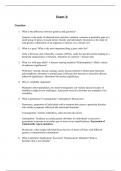Exam (elaborations)
Exam_2_NSG_533 latest complete update A+ graded.
- Course
- Institution
Exam 2: Genetics: 1. What is the difference between genetics and genomics? Genetics is the study of inherited traits and their variation, examines a particular gene or a small group of genes, focused picture (family and individual). Genomics is the study of total genetic composition of an ...
[Show more]



